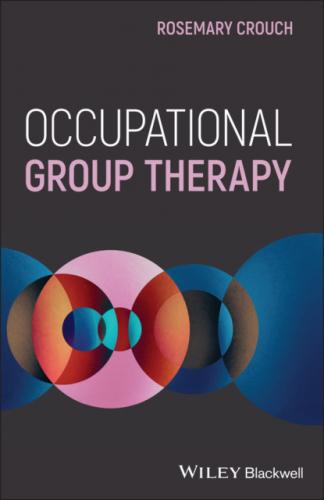Occupational Group Therapy. Rosemary Crouch
which you will act and treat others in the group’ (p. 14, Chapter 4). She also states that ‘groups present a small society and have the same ingredients as any community’.
What are the curative factors? These are the specific aspects of groups that make them therapeutic and conducive to good health. Fouché in 2020 stated that ‘As occupational therapists, we are goal‐directed and therefore need to select appropriate curative factors which we would like to facilitate within each group’ (See Chapter 4).
Theorists such as Yalom (1975) and Rogers (1961) have laid down the basic premises of the curative factors which are to be found within the processes of the group. Curative factors are strongly related to the dynamics of a group; for example cohesiveness, a basic dynamic which is essential to any group work, is the curative factor which allows members to be understood and feel safe. They also feel they are of value to the group.
Other curative factors are well defined by Yalom (1975) and include:
Instillation of hope.
Universality.
Imparting of information.
Altruism.
The recapitulation of the primary family.
Developing socialisation techniques.
Existential factors.
Imitative behaviour.
Group cohesiveness.
Interpersonal learning.
Catharsis.
Reflective appreciation.
These important factors are brought about mostly, but not entirely by the group leader's style and skill. All groups have to have a leader, which is described in this literature as the occupational therapist, but when working in a transdisciplinary setting may be another professional or a family member or layperson. It will depend on the setting.
Leaderless groups in any setting can become very destructive particularly in a clinical setting. Group members struggle to take over the group causing friction and conflict. It is very difficult to reach treatment goals. The dynamics of groups tell us that there is always a natural leader of any group of people but as occupational therapists, who are well trained in group work, we must be sure that the natural leader is the right person before allowing him/her to lead the group. They must be able to bring about the curative factors as described by Yalom.
1.2 CLASSIFICATION OF GROUPS AND TYPES OF OCCUPATIONAL GROUP THERAPY: DEFINING THE SCOPE OF OCCUPATIONAL GROUP THERAPY ACCORDING TO THE LEVEL OF EMOTIONAL INTENSITY
All types of occupational group therapy, from the simplest ADL (Activities of Daily Living) group to the more dynamic groups like psychodrama and assertiveness training are considered to be therapy. Linda Finlay (2002) states that: ‘A classification of groups should not be interpreted rigidly. Any activity can be designed to fit along the continuum of task‐social‐communication‐psychotherapy. In fact, all the elements may be on offer in any one group but shift according to what the group is doing and group member's responses’ (Figure 1.1).
Model 1.1 is based on Finlay's model in Creek (2002, p. 246). Finlay addresses the approaches to group work in occupational therapy as:
Skills‐focused groups.
Occupational behaviour groups.
Cognitive behavioural groups.
Psychodynamic creative therapy groups (Finlay in Creek 2002).
In the Position Statement on therapeutic group work in occupational therapy, the Occupational Therapy Association of South Africa (OTASA) states that ‘Group work should address dysfunctional occupational performance area(s). In a mental health‐care setting, social participation is often problematic, impacting occupational performance areas such as play, schooling and work. The occupational therapist facilitates the group in such a way that each group member's poor social skills and impaired ability to build healthy interpersonal relationships i.e. social participation are addressed irrespective of the theme that is presented. Social skills are practised when interaction is actively facilitated within the group context’ (OTASA 2014).
FIGURE 1.1 Diagram depicting the emotional categories of occupational group therapy.
Source: Crouch and Fouché 2018.
Types of groups:
Groups to facilitate psychosocial adjustment to disability/illness.
Education groups.
Team‐building groups.
Exercise groups.
Skills training groups.
Group empowerment.
Functional Group Categories are also described by Howe and Schwartzberg in 1986. This progression shows the increase of emotional involvement on behalf of the group member. The categories are as follows:
Activity groups:These are groups where members are involved in a common activity and are directed towards learning and maintaining occupational performance. This is explained in detail in Chapter 14.
Intrapsychic groups:These are groups which deal with the insight into processes and conflicts that can occur within an individual. Psychodrama is a typical intrapsychic group and is explained in detail in Chapter 11.
Social Systems groups:These are groups which follow the Systems Theory developed by Lewin (1951). They are aimed at increasing the interaction of participants.
Growth groups:Growth Groups are generally aimed at increasing members' sensitivity to feelings or enhancing members ‘ability to help them through the power of the group’. Howe and Schwartzberg (1986, p. 31).They are aimed at personal growth through action‐orientated experiences. Growth groups are based on the principles of humanistic and existential philosophy and psychology that seek to fulfil the potential inherent in each person. These principles are explained in the writing of Rogers (1961), Shutz (1967), Perls et al. (1971) and Maslow (1962). Groups such as psychodrama, role‐play and assertiveness training fall into this category.
Finlay succinctly describes the difference between group work and individual therapy. She states that ‘both have their values for particular people, times and situations’ (Finlay in Creek 2002, p. 249). She further states that ‘Group work will be an appropriate choice of treatment if the patient or client:
has the skills and awareness to interact and share with others in a group
has problems related to social interaction and relationships
feels isolated and is without others to offer support or constructive advice
is threatened by the intensity or intimacy of one‐to‐one work’.
Groups falling out of the occupational therapy scope in South Africa but in which occupational therapists may be involved are as follows:
Family Therapy groups.
Social
